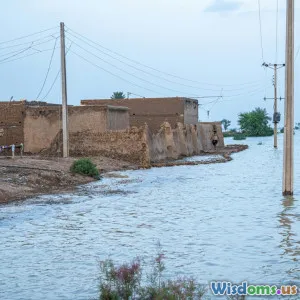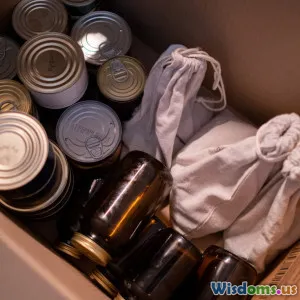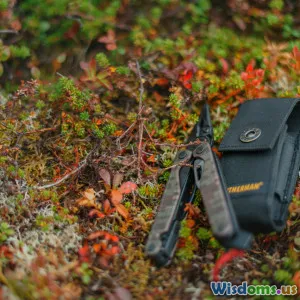
How to Build a Safe Tornado Shelter on a Budget
8 min read Learn how to build a cost-effective, safe tornado shelter with practical tips and expert guidance to protect your loved ones during severe storms. (0 Reviews)
How to Build a Safe Tornado Shelter on a Budget
Tornadoes are among nature's most powerful and destructive forces. If you live in a tornado-prone area, having a safe shelter can be life-saving. Sadly, many assume tornado shelters are too costly, leaving households vulnerable. But what if you could build a sturdy, FEMA-compliant tornado shelter without draining your savings?
In this comprehensive guide, we'll explore practical, budget-friendly methods to construct a tornado shelter that provides maximum safety and peace of mind for your family. From understanding essential shelter components to selecting cost-effective materials and adhering to safety standards, this article empowers you with knowledge to take action.
Why Building a Tornado Shelter Matters
Tornadoes can unleash winds exceeding 200 miles per hour, destroying homes and endangering lives in mere minutes. According to the National Oceanic and Atmospheric Administration (NOAA), the United States records over 1,000 tornadoes annually, with the Midwest and Southern states most affected.
Research indicates that people who have access to a FEMA-compliant tornado shelter significantly reduce their chances of injury or fatality during an event. Given the increasing severity of storms due to climate changes, a tornado shelter is a critical safety investment.
Planning Your Tornado Shelter
Assess Your Risk and Decide Shelter Type
Before building, evaluate your location's tornado risk by consulting the Enhanced Fujita Scale zones and local weather data. The severity of tornadoes in your area influences your shelter design choice.
There are broadly two types of shelters:
- Above-Ground Shelters: Easier to construct and less expensive but require strong materials and anchoring.
- Below-Ground Shelters: Provide better protection ideally but often costlier and require excavation.
Abiding by Local Regulations and obtaining permits is essential for legal and safe construction.
Choose an Accessible Location
Aim for a shelter close to your primary living space for quick access. If underground, choose well-drained, stable soil to prevent flooding. Positioned near utilities can aid ventilation but keep electrical components protected.
Safety Standards and Guidelines
Follow FEMA's Tornado Shelter Guidelines
FEMA Publ 320 outlines rigorous design standards for tornado shelters, focusing on:
- Impact resistance to flying debris
- Wind pressure resilience
- Proper ventilation and emergency provisions
Even on a budget, meeting these minimum criteria ensures your shelter isn’t just cheaper but safe.
Material Strength and Structural Integrity
Choose materials rated for SBA or ASTM impact tests, especially for walls and doors. Materials should sustain a strike from a 15-pound 2x4 flying at 100 mph.
Budget-Friendly Material Choices
Reinforced Concrete Blocks
Concrete blocks cost-effective and strong; adding steel rebar gives them critical reinforcement. They're widely available, require minimal finishing, and resist debris impacts well.
Steel Helmets and Doors
Construct or purchase a steel door rated for tornado resistance. It may be the pricier element but key to maintaining shelter integrity. DIY options include reinforcing an existing door with steel sheets and heavy-duty hinges.
Recycled Materials
Salvaged steel, reclaimed wood (non-load-bearing parts), and leftover construction concrete can cut costs. Ensure recycled materials meet safety standards and are not compromised by weathering.
DIY vs. Professional Contractors
For tight budgets, DIY construction can save labor costs but requires skill, time, and attention to detail.
Hiring a partial contractor for critical operations like pouring concrete or electrical setup can be a balanced approach.
Step-by-Step Construction Process
1. Foundation and Excavation
If building underground, dig a shelter hole 6-8 feet deep. Lay a compacted gravel base for drainage.
For above-ground, pour a reinforced concrete slab foundation to avoid uplift during high winds.
2. Wall Construction
Use reinforced concrete blocks to build the walls. Insert vertical and horizontal rebar as per design specs.
Ensure wall thickness is at least 6 inches for strength.
3. Roof and Ceiling
Use a reinforced concrete slab roof or a heavy steel panel securely anchored. Roof design should account for debris impact and prevent rollover.
4. Door Installation
Install a tornado-rated steel door with robust locking mechanisms.
Seal openings with weatherproof gaskets.
5. Ventilation and Emergency Provisions
Include screened ventilation openings that conform to FEMA’s airflow specifications without compromising debris protection.
Stock the shelter with essentials: water, non-perishable food, flashlight, weather radio, first aid kit, and communication devices.
Cost-Saving Tips
- Compare Material Prices: Purchase bulk or at surplus sales to reduce costs.
- Plan Precisely: Minimizing shelter size while accommodating necessary occupants reduces materials cost.
- Volunteer Labor: If possible, ask family or friends experienced in construction for help.
- Phased Building: Build key safety elements initially and upgrade shelter amenities over time.
Real-Life Example: Community Shelter Initiative
In Oklahoma, a community of tornado-prone residents pooled resources to build shared underground shelters with economical design features like pre-fabricated concrete slabs and locally sourced materials, reducing costs by nearly 40%. Collaborative efforts like this model safety and affordability synergy.
Maintaining Your Shelter
Routine checks for cracks, water intrusion, door function, and ventilation are critical.
Maintain emergency supplies and rotate them annually.
Conclusion: Protecting Lives Without Overspending
A tornado shelter is more than an expense; it's a vital security measure, and affordability should never compromise safety. With proper planning, adherence to FEMA guidelines, and prudent material choices, building a safe tornado shelter on a budget is achievable.
Preparing your home with a reliable tornado haven protects not only your family but provides invaluable peace of mind when nature's fury strikes. Start now — your timely shelter is literally lifesaving.
Sources:
- FEMA Publication 320: Taking Shelter from the Storm: Building a Safe Room Inside Your House
- NOAA Storm Prediction Center
- The American Red Cross Tornado Safety Guide
- Community Tornado Shelter Projects Case Studies
Expert Quote: John Leschin, Structural Engineer with 20 years specializing in disaster-resilient construction, states: "Affordable tornado shelters don’t mean cutting corners. Clever design and community-driven projects can ensure safe, cost-effective protective spaces."
Rate the Post
User Reviews
Popular Posts


















